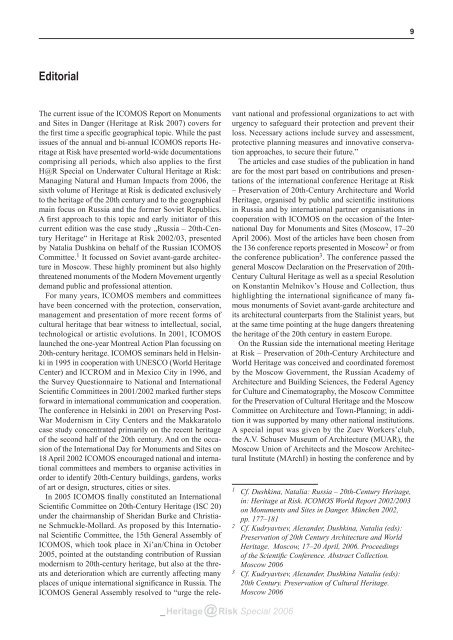The Soviet Heritage and European Modernism - Heritage ... - Icomos
The Soviet Heritage and European Modernism - Heritage ... - Icomos
The Soviet Heritage and European Modernism - Heritage ... - Icomos
Create successful ePaper yourself
Turn your PDF publications into a flip-book with our unique Google optimized e-Paper software.
Editorial<br />
<strong>The</strong> current issue of the ICOMOS Report on Monuments<br />
<strong>and</strong> Sites in Danger (<strong>Heritage</strong> at Risk 2007) covers for<br />
the first time a specific geographical topic. While the past<br />
issues of the annual <strong>and</strong> bi-annual ICOMOS reports <strong>Heritage</strong><br />
at Risk have presented world-wide documentations<br />
comprising all periods, which also applies to the first<br />
H@R Special on Underwater Cultural <strong>Heritage</strong> at Risk:<br />
Managing Natural <strong>and</strong> Human Impacts from 2006, the<br />
sixth volume of <strong>Heritage</strong> at Risk is dedicated exclusively<br />
to the heritage of the 20th century <strong>and</strong> to the geographical<br />
main focus on Russia <strong>and</strong> the former <strong>Soviet</strong> Republics.<br />
A first approach to this topic <strong>and</strong> early initiator of this<br />
current edition was the case study „Russia – 20th-Century<br />
<strong>Heritage</strong>“ in <strong>Heritage</strong> at Risk 2002/03, presented<br />
by Natalia Dushkina on behalf of the Russian ICOMOS<br />
Committee. 1 It focussed on <strong>Soviet</strong> avant-garde architecture<br />
in Moscow. <strong>The</strong>se highly prominent but also highly<br />
threatened monuments of the Modern Movement urgently<br />
dem<strong>and</strong> public <strong>and</strong> professional attention.<br />
For many years, ICOMOS members <strong>and</strong> committees<br />
have been concerned with the protection, conservation,<br />
management <strong>and</strong> presentation of more recent forms of<br />
cultural heritage that bear witness to intellectual, social,<br />
technological or artistic evolutions. In 2001, ICOMOS<br />
launched the one-year Montreal Action Plan focussing on<br />
20th-century heritage. ICOMOS seminars held in Helsinki<br />
in 1995 in cooperation with UNESCO (World <strong>Heritage</strong><br />
Center) <strong>and</strong> ICCROM <strong>and</strong> in Mexico City in 1996, <strong>and</strong><br />
the Survey Questionnaire to National <strong>and</strong> International<br />
Scientific Committees in 2001/2002 marked further steps<br />
forward in international communication <strong>and</strong> cooperation.<br />
<strong>The</strong> conference in Helsinki in 2001 on Preserving Post-<br />
War <strong>Modernism</strong> in City Centers <strong>and</strong> the Makkaratolo<br />
case study concentrated primarily on the recent heritage<br />
of the second half of the 20th century. And on the occasion<br />
of the International Day for Monuments <strong>and</strong> Sites on<br />
18 April 2002 ICOMOS encouraged national <strong>and</strong> international<br />
committees <strong>and</strong> members to organise activities in<br />
order to identify 20th-Century buildings, gardens, works<br />
of art or design, structures, cities or sites.<br />
In 2005 ICOMOS finally constituted an International<br />
Scientific Committee on 20th-Century <strong>Heritage</strong> (ISC 20)<br />
under the chairmanship of Sheridan Burke <strong>and</strong> Christiane<br />
Schmuckle-Mollard. As proposed by this International<br />
Scientific Committee, the 15th General Assembly of<br />
ICOMOS, which took place in Xi’an/China in October<br />
2005, pointed at the outst<strong>and</strong>ing contribution of Russian<br />
modernism to 20th-century heritage, but also at the threats<br />
<strong>and</strong> deterioration which are currently affecting many<br />
places of unique international significance in Russia. <strong>The</strong><br />
ICOMOS General Assembly resolved to “urge the relevant<br />
national <strong>and</strong> professional organizations to act with<br />
urgency to safeguard their protection <strong>and</strong> prevent their<br />
loss. Necessary actions include survey <strong>and</strong> assessment,<br />
protective planning measures <strong>and</strong> innovative conservation<br />
approaches, to secure their future.”<br />
<strong>The</strong> articles <strong>and</strong> case studies of the publication in h<strong>and</strong><br />
are for the most part based on contributions <strong>and</strong> presentations<br />
of the international conference <strong>Heritage</strong> at Risk<br />
– Preservation of 20th-Century Architecture <strong>and</strong> World<br />
<strong>Heritage</strong>, organised by public <strong>and</strong> scientific institutions<br />
in Russia <strong>and</strong> by international partner organisations in<br />
cooperation with ICOMOS on the occasion of the International<br />
Day for Monuments <strong>and</strong> Sites (Moscow, 17–20<br />
April 2006). Most of the articles have been chosen from<br />
the 136 conference reports presented in Moscow 2 or from<br />
the conference publication 3 . <strong>The</strong> conference passed the<br />
general Moscow Declaration on the Preservation of 20th-<br />
Century Cultural <strong>Heritage</strong> as well as a special Resolution<br />
on Konstantin Melnikov’s House <strong>and</strong> Collection, thus<br />
highlighting the international significance of many famous<br />
monuments of <strong>Soviet</strong> avant-garde architecture <strong>and</strong><br />
its architectural counterparts from the Stalinist years, but<br />
at the same time pointing at the huge dangers threatening<br />
the heritage of the 20th century in eastern Europe.<br />
On the Russian side the international meeting <strong>Heritage</strong><br />
at Risk – Preservation of 20th-Century Architecture <strong>and</strong><br />
World <strong>Heritage</strong> was conceived <strong>and</strong> coordinated foremost<br />
by the Moscow Government, the Russian Academy of<br />
Architecture <strong>and</strong> Building Sciences, the Federal Agency<br />
for Culture <strong>and</strong> Cinematography, the Moscow Committee<br />
for the Preservation of Cultural <strong>Heritage</strong> <strong>and</strong> the Moscow<br />
Committee on Architecture <strong>and</strong> Town-Planning; in addition<br />
it was supported by many other national institutions.<br />
A special input was given by the Zuev Workers’club,<br />
the A.V. Schusev Museum of Architecture (MUAR), the<br />
Moscow Union of Architects <strong>and</strong> the Moscow Architectural<br />
Institute (MArchI) in hosting the conference <strong>and</strong> by<br />
1<br />
Cf. Dushkina, Natalia: Russia – 20th-Century <strong>Heritage</strong>,<br />
in: <strong>Heritage</strong> at Risk. ICOMOS World Report 2002/2003<br />
on Monuments <strong>and</strong> Sites in Danger. München 2002,<br />
pp. 177–181<br />
2<br />
Cf. Kudryavtsev, Alex<strong>and</strong>er, Dushkina, Natalia (eds):<br />
Preservation of 20th Century Architecture <strong>and</strong> World<br />
<strong>Heritage</strong>. Moscow, 17–20 April, 2006. Proceedings<br />
of the Scientific Conference. Abstract Collection.<br />
Moscow 2006<br />
3<br />
Cf. Kudryavtsev, Alex<strong>and</strong>er, Dushkina Natalia (eds):<br />
20th Century. Preservation of Cultural <strong>Heritage</strong>.<br />
Moscow 2006<br />
_ <strong>Heritage</strong> @ Risk Special 2006

















